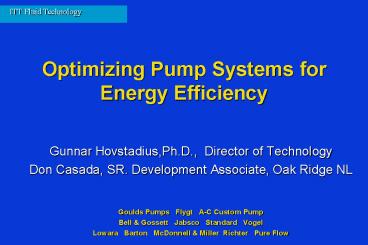Optimizing Pump Systems for Energy Efficiency - PowerPoint PPT Presentation
1 / 31
Title:
Optimizing Pump Systems for Energy Efficiency
Description:
ITT Fluid Technology Optimizing Pump Systems for Energy Efficiency Gunnar Hovstadius,Ph.D., Director of Technology Don Casada, SR. Development Associate, Oak Ridge NL – PowerPoint PPT presentation
Number of Views:98
Avg rating:3.0/5.0
Title: Optimizing Pump Systems for Energy Efficiency
1
Optimizing Pump Systems for Energy Efficiency
ITT Fluid Technology
- Gunnar Hovstadius,Ph.D., Director of Technology
- Don Casada, SR. Development Associate, Oak Ridge
NL - Goulds Pumps Flygt A-C Custom Pump
- Bell Gossett Jabsco Standard Vogel
- Lowara Barton McDonnell Miller Richter
Pure Flow
2
What Is A Pump System?
- A Pump System comprises of all piping, fittings
and valves before and after a pump as well as the
motor and motor driver. - There can be multiple pumps, motors and drives,
and they can be arranged to operate in parallel
or in series. - Pump Systems can have static head (pressure), or
be circulating systems (friction only systems)
3
First, Let's Get A Big Picture PerspectiveOf
Energy Flow in Pumping Systems
Electric utility feeder
At each interface, there are inefficiencies. The
goal should be to maximize the overall cost
effectiveness of the pumping, or how much flow is
delivered per unit of input energy.
Transformer
Motor breaker/ starter
Adjustable speed drive (electrical)
Ultimate goal
Fluid system
Motor
Coupling
Pump
4
Specific Energy Es
g
r
Es
fHS
h
p
h
Motor efficiency Pump efficiency
m
h
p
5
Observations On Some OfThe Power Train Components
Utility system - line losses (we cant do much
about that) Transformer - Very efficient
(typically high 90s ) Breaker/starter -
negligible losses Adjustable speed drive - To be
discussed Motor - To be discussed Coupling -
Losses better be minor! Pump - To be
discussed System - To be discussed Ultimate goal
- To be discussed
6
Understand The Ultimate Goal
Electric utility feeder
Maximize the overall effectiveness.
Transformer
Motor breaker/ starter
Adjustable speed drive (electrical)
Ultimate goal
Fluid system
Motor
Coupling
Pump
7
It Is Essential To Understand TheUltimate Goal
Of The Fluid System To Optimize It
- Understand why the system exists
- Have clearly defined criteria for what is really
needed - Understand what's negotiable and what's not
8
Requirements For Designing A System
- Duration Curve (Flow)
- System Curve (Pressure vs. Flow)
- Pump Component selection
9
Annualized Flow Duration Curve
10
Understand The Fluid System
Electric utility feeder
Maximize the overall effectiveness.
Transformer
Motor breaker/ starter
Adjustable speed drive (electrical)
Fluid system
Ultimate goal
Motor
Coupling
Pump
11
System Curves Are Made Up Of Two
FundamentalComponents - The Static Head And The
Frictional Head
120
80
Head, ft
40
0
5000
4000
3000
2000
1000
0
Flow rate, gpm
12
Hydraulic System Factor
f
HS
f
- The Hydraulic System factor is defined
as The ratio of a hydraulic systems static head
to total head.
HS
13
What Are Some Sources OfFriction In Pumping
Systems?
Pipe walls Valves Elbows Tees Reducers/expanders E
xpansion joints Tank inlets/outlets (In other
words, almost everything that the pumped fluid
passes through, as well as the fluid itself)
14
Operational Costs Are Influenced By The Selection
Of Components And Their Size
15
Annual Frictional Cost Per 100 ft Of Pipe
Assumptions 80 combined pump and motor
efficiency, electricity cost 10 /kWh
16
Frictional Losses Can BeTranslated Into
Operating Costs
12-inch line, 100 ft length, 10/kWh, full open
valves, 80 combined pump motor efficiency
Assumptions
17
Understanding The Pump
Electric utility feeder
Maximize the overall effectiveness
Transformer
Motor breaker/ starter
Adjustable speed drive (electrical)
Pump
Fluid system
Ultimate goal
Motor
Coupling
18
Nameplate Data Applies ToOne Particular
Operating Point
200
150
Head-capacity curve
Head, ft
100
Rated 3190 gpm, 97 ft
50
0
5000
4000
3000
2000
1000
0
Flow rate, gpm
19
How Do We Know Where We'll BeOperating On The
Pump Curve?
Pump head curve
Nameplate
System head curve
Pump and system curve intersection (operating
point)
20
Efficiency And Brake Horsepower AreCommonly
Plotted vs. Pump Flow
BEP
Operating point
21
Using A Larger Pipe Changes TheFrictional Part
Of The System Curve
System head, 12" pipe
System head, 16" pipe
22
(No Transcript)
23
Specific Energy in Three Different Single Pump
Systems
24
Now Let's Look At The Electrical End Of The Shaft
Electric utility feeder
Maximize the overall effectiveness
Transformer
Motor breaker/ starter
Adjustable speed drive (electrical)
Fluid system
Ultimate goal
Motor
Coupling
Pump
25
Motor Efficiency CurvesAre Dependent Upon Size
And Type
26
Understanding Drive Performance
Electric utility feeder
Maximize the overall effectiveness
Transformer
Motor breaker/ starter
Adjustable speed drive (electrical)
Fluid system
Ultimate goal
Motor
Coupling
Pump
27
The Efficiency Of InvertersIs Affected By
Operating Speed
Typical inverter efficiencies as a function of
motor speed
28
Evaluate System Design
- Is the system effectiveness acceptable?
- If the system has static head, Compare with
frictionless performance!
29
Re-Evaluate System Choices Relative To Needs
- Number of pumps
- Pump sizes
- VFD operation?
- Pipe diameters
- Component selection
30
When the System is Commissioned the Theoretical
Calculations Should be Compared to Actual
Operational Data to Ensure that it is Operating
as Intended
31
Summary
- Most avoidable losses are in the pump and fluid
system, not in the electrical front end - However, the electrical front end can help reduce
the fluid system losses - Be careful with local optimization
- Determine the specific energy and compare with
the ideal
32
THANK YOUGunnar Hovstadiusemail
gunnar_hovstadius_at_fluids.ittind.com































